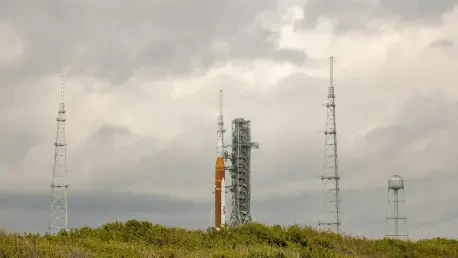China’s ascent as a global space power has been nothing short of remarkable, with the recent launch of the Yaogan-40 (03) group of remote sensing satellites serving as a prime example of the nation’s unrelenting ambition to dominate in this field. On September 6, a Long March 6A rocket lifted off from the Taiyuan Satellite Launch Center in North China, marking the country’s 52nd orbital launch of the year and highlighting a pace that could shatter previous national records. This mission, confirmed successful just an hour after launch, underscores a broader trend of rapid expansion in China’s space endeavors. While the official narrative describes these satellites as tools for electromagnetic environment detection and technical testing, speculation abounds regarding their dual-use potential. This development raises questions about the strategic drivers behind such frequent and diverse missions, positioning China as a formidable player in the global space arena and prompting a closer examination of its objectives and capabilities.
Unveiling the Strategic Importance of Yaogan-40
The Yaogan-40 (03) launch represents more than just another addition to China’s satellite constellation; it reflects a calculated effort to enhance global monitoring capabilities. Likely positioned in near-polar orbits at an altitude of around 850 kilometers with an 86-degree inclination, these satellites are believed to join two earlier groups launched in recent years. Analysis from experts suggests a unique equilateral triangle formation for these spacecraft, optimized for tasks like radio frequency monitoring and geolocation, especially over polar regions. Such configurations indicate a sophisticated approach to data collection that extends far beyond the civilian purposes often cited by authorities, such as land surveys or disaster prevention. Instead, the design and orbital placement hint at a broader intent to secure comprehensive coverage, potentially for strategic intelligence purposes, showcasing how China leverages advanced technology to maintain a competitive edge in space.
Beyond the technical specifics, the Yaogan-40 series exemplifies China’s ability to integrate military and civilian objectives under a veil of ambiguity. Official statements remain vague, often describing missions in broad terms that obscure their true intent. Yet, many analysts agree that these satellites likely contribute to optical imaging, synthetic aperture radar (SAR), and electronic intelligence (ELINT), serving national security interests alongside environmental or agricultural applications. This dual-use strategy allows China to maximize the utility of each launch while maintaining a degree of plausible deniability about military functions. The opacity surrounding these missions fuels international curiosity and concern, as the balance between peaceful exploration and strategic dominance becomes increasingly blurred. This pattern of deployment reveals a deliberate effort to build a robust space infrastructure capable of supporting multiple national priorities simultaneously.
Accelerating Launch Cadence and Diverse Missions
China’s space program is not only defined by the sophistication of missions like Yaogan-40 but also by the sheer volume and variety of its launch activities. With 52 orbital launches already completed this year, the nation is on track to exceed its previous record of 68 set last year, despite minor setbacks such as a failed commercial launch in August. Recent missions include a Long March 3C rocket deploying the experimental Shiyan-29 satellite into a geosynchronous orbit and a commercial Ceres-1 rocket carrying multiple payloads. Upcoming launches, such as a sea-based mission from the Yellow Sea and another from Wenchang Satellite Launch Center, further illustrate the relentless pace. This diversity in launch vehicles and objectives—from experimental to commercial—demonstrates a comprehensive approach to space exploration, positioning China to address both immediate tactical needs and long-term strategic goals with remarkable efficiency.
The integration of commercial entities into this ambitious schedule marks another layer of China’s space strategy. Companies like GeeSpace, a subsidiary of automaker Geely, are becoming active participants, with planned launches that complement state-led efforts. This synergy between public and private sectors enhances resource allocation and innovation, allowing for a broader range of missions and faster development cycles. The ability to conduct frequent launches across various platforms and orbits, including polar and geosynchronous, underscores a logistical prowess that few nations can match. It also reflects a national commitment to self-reliance in space technology, reducing dependence on foreign systems while expanding global influence. As these efforts continue to ramp up, the international community watches closely, recognizing that each successful mission strengthens China’s position as a leader in the increasingly competitive domain of space.
Future Implications of China’s Space Ambitions
Looking ahead, the trajectory of China’s space program, as evidenced by missions like Yaogan-40, suggests a sustained focus on expanding capabilities and asserting dominance in critical orbital regions. The strategic placement of satellites for global monitoring, particularly in polar orbits, ensures comprehensive data collection that can inform both civilian and military decision-making. This relentless pursuit of space infrastructure points to a long-term vision of establishing a presence that rivals or surpasses other leading spacefaring nations. For policymakers and analysts worldwide, understanding the drivers behind this expansion—be it technological innovation, national security, or economic gain—becomes essential. Keeping abreast of these developments will be crucial for anticipating shifts in global space dynamics over the coming years.
Reflecting on past achievements, the successful deployment of the Yaogan-40 (03) group stands as a testament to China’s meticulous planning and execution in space endeavors. Each mission completed adds to a growing network of assets that support a wide array of functions, from environmental monitoring to intelligence gathering. The collaboration between state and commercial entities also proves to be a game-changer, amplifying the scope and impact of these initiatives. Moving forward, stakeholders globally are encouraged to consider cooperative frameworks or dialogues that could address the uncertainties surrounding dual-use technologies. Exploring avenues for transparency or joint ventures might mitigate tensions, while investing in parallel capabilities could ensure a balanced approach to space exploration in the years that follow.









